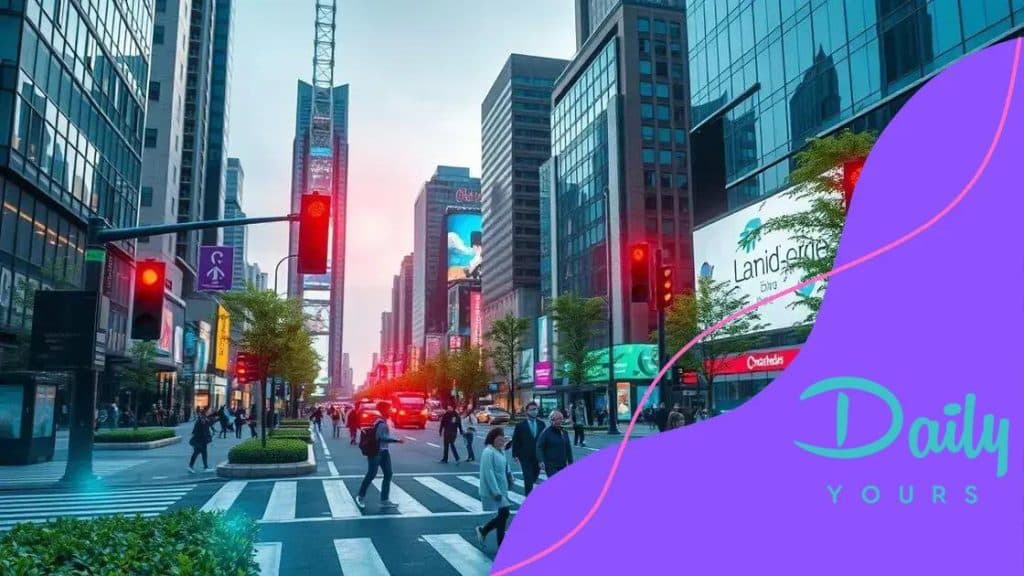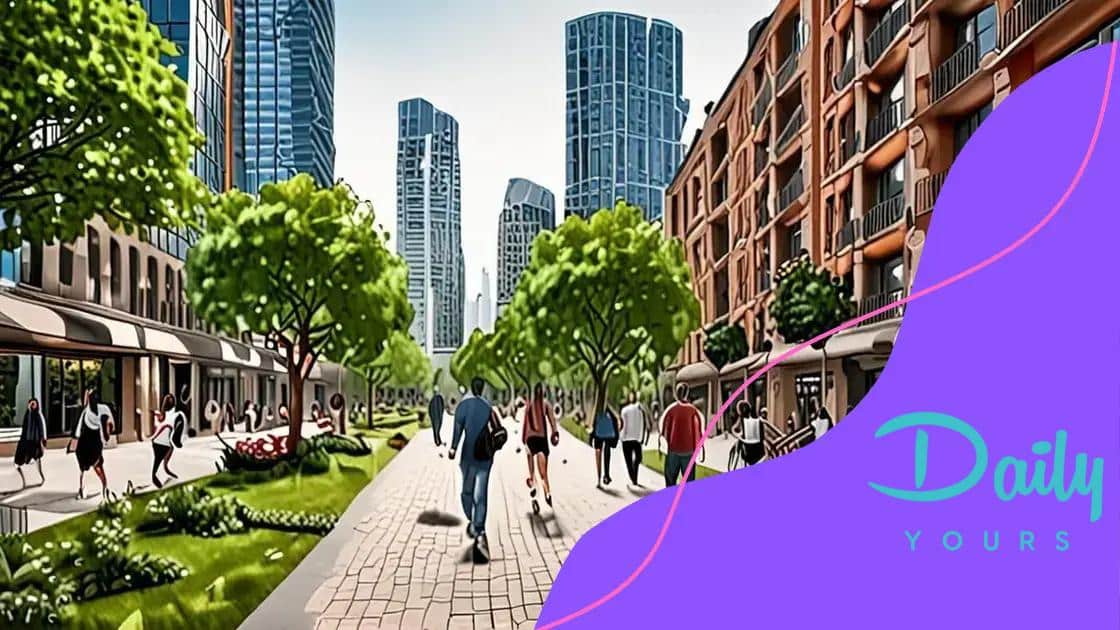Smart cities: The future of urban living

Anúncios
Smart cities leverage technology and data to improve urban living by enhancing connectivity, sustainability, and community engagement, ultimately resulting in a higher quality of life for residents.
Smart cities: The future of urban living presents a fascinating perspective on how technology can reshape our environments. Have you ever wondered how your daily life could change with advancements in urban planning? Let’s dive into the innovations that are making cities smarter and more livable.
Anúncios
What are smart cities?
Smart cities are urban areas that utilize technology and data to enhance the quality of life for their residents. These cities aim to improve efficiency, sustainability, and connectivity through innovative solutions.
By embracing digital infrastructure, smart cities can transform how we live, work, and interact. Imagine a place where real-time data helps reduce traffic, enhances public safety, and conserves energy—all contributing to a more livable environment.
Key Features of Smart Cities
Several features define a smart city and set it apart from traditional urban landscapes. These include:
Anúncios
- Intelligent transportation systems that optimize traffic flow and reduce congestion.
- Smart energy grids that manage and distribute energy more efficiently, promoting sustainability.
- Data-driven public services that respond quickly to citizens’ needs through better resource management.
- Wi-Fi accessibility that enables residents to stay connected anywhere they go.
Moreover, smart cities monitor environmental conditions, ensuring a healthier atmosphere. They leverage technology to offer real-time information about air quality, waste management, and public health. This not only empowers residents to make informed choices but also facilitates community engagement.
The Role of Technology in Smart Cities
Technology acts as the backbone of a smart city, integrating different systems and providing services seamlessly. From sensors that track traffic patterns to apps that allow citizens to report issues, every element works in harmony. This interconnectedness can lead to substantial economic benefits as well, with improved efficiency translating into cost savings for both the city and its residents.
Ultimately, as we move towards a more urbanized world, understanding what makes a city ‘smart’ becomes crucial. By embracing these innovations, cities can offer a better quality of life while addressing essential challenges like climate change and resource scarcity.
Key technologies driving smart cities
Several key technologies are driving the evolution of smart cities, creating vibrant urban environments that enhance daily life. These innovations play a crucial role in making cities more efficient, responsive, and sustainable.
Internet of Things (IoT)
The Internet of Things is at the heart of many smart city initiatives. Connected devices collect and share data, allowing for improved decision-making. From smart meters that monitor energy use to sensors that track traffic patterns, IoT technology creates a connected ecosystem.
- Smart lighting systems that adjust based on real-time data.
- Waste management solutions that optimize collection routes.
- Environmental sensors that monitor air quality.
By leveraging IoT, cities can become more adaptive and proactive in addressing urban challenges.
Data Analytics
Data analytics is another critical technology that empowers smart cities. This process involves analyzing vast amounts of information collected from various sources. By using data analytics, cities can identify trends, optimize services, and respond quickly to issues.
For example, cities can track public transportation usage patterns to enhance service frequency or detect anomalies in traffic flow to reroute vehicles efficiently. Such insights lead to more informed urban planning.
5G Connectivity
5G networks provide the speed and reliability needed for various smart city applications. High-speed internet connections enable real-time communication between devices, which is essential for smart infrastructure.
This enhanced connectivity supports technologies like autonomous vehicles and remote health monitoring systems. As cities adopt 5G technology, they unlock new opportunities for innovation and growth.
Overall, the integration of these key technologies—IoT, data analytics, and 5G—is transforming urban living. By building smart solutions around them, cities are not only improving their services but also shaping a better future for their residents.
Benefits of smart cities for residents

Smart cities provide numerous benefits for residents that significantly enhance their quality of life. These advantages arise from the implementation of technology and innovation aimed at creating more efficient, sustainable, and connected urban environments.
Enhanced Quality of Life
Living in a smart city means enjoying improved amenities and services. For instance, smart waste management systems ensure that garbage is collected more efficiently, keeping neighborhoods cleaner. Additionally, smart parks and public spaces equipped with free Wi-Fi and interactive elements encourage community engagement.
- Access to real-time public transportation information.
- Safer streets through smart lighting and surveillance systems.
- Increased availability of green spaces and recreational areas.
These enhancements create a more vibrant and enjoyable living atmosphere.
Better Transportation
Transportation is another area where smart cities shine. With the integration of technology, traffic congestion can be reduced through intelligent traffic management systems. These systems analyze traffic flow and adjust signals in real time to keep vehicles moving smoothly.
Moreover, real-time data helps residents plan their journeys and minimize wait times. This leads to less frustration and more time enjoying what the city has to offer.
Environmental Sustainability
Smart cities prioritize sustainability, which benefits residents by promoting a healthier environment. Energy-efficient buildings, smart grids, and renewable energy sources contribute to reduced carbon footprints.
With better air quality and conservation measures in place, residents enjoy a cleaner and safer living space. Smart cities also implement initiatives for recycling and waste reduction, which fosters a sense of community responsibility.
In sum, the benefits of living in a smart city extend beyond mere convenience. They contribute to an enriched lifestyle, making urban areas more enjoyable and sustainable for all citizens.
Challenges in developing smart cities
Developing smart cities comes with several challenges that urban planners and policymakers must navigate. While the benefits can be significant, addressing these obstacles is crucial for successful implementation.
High Initial Costs
One of the main challenges is the high initial costs associated with creating a smart city. Implementing advanced technologies requires substantial investment in infrastructure, software, and training. Cities often need to allocate significant budgets for these projects, potentially diverting funds from other essential services.
- Costs for installing smart sensors and equipment.
- Expenses related to upgrading existing infrastructure.
- Investment in cybersecurity measures to protect data.
These financial commitments can pose a barrier, especially for smaller municipalities.
Data Privacy Concerns
With the increase in data collection, concerns about privacy also arise. Residents may feel uneasy about how their data is being used and who has access to it. As smart cities gather vast amounts of information, ensuring data protection becomes critical.
Transparency in data usage and strong cybersecurity protocols are necessary to gain public trust. Cities need to prioritize ethical data practices to alleviate these concerns.
Integration of Systems
Another challenge is the integration of various systems and technologies. For a city to be truly smart, different systems—from traffic management to public safety—must work together seamlessly. This requires coordinated efforts between multiple departments and agencies.
Additionally, legacy systems can pose integration challenges, making it difficult to incorporate new technologies. Cities must invest in comprehensive planning to ensure a cohesive approach.
Public Engagement and Acceptance
Lastly, public engagement is crucial for the success of smart city initiatives. Residents must understand how these technologies will benefit them and be active participants in the development process. If citizens are not informed or involved, there may be resistance to new programs and technologies.
City officials should focus on community outreach to educate residents and gather feedback. Engaging the public fosters a sense of ownership and encourages collaboration in creating a smarter urban space.
The future outlook for urban living
The future outlook for urban living is filled with exciting possibilities as cities evolve into smart cities. This transformation will significantly impact how residents experience their daily lives.
Increased Connectivity
One key aspect of the future is the increased connectivity among urban environments. With the expansion of 5G technology and the Internet of Things (IoT), devices will communicate seamlessly. This means residents will access services and information instantly, whether checking traffic on their way to work or controlling their home appliances remotely.
- Smart public transportation systems that provide real-time updates.
- Connected streetlights that adapt to traffic flow.
- Enhanced communication between emergency services and citizens.
Such connectivity will make cities not only more efficient but also safer for everyone.
Sustainability Efforts
Another essential element of the future outlook is sustainability. Urban areas will increasingly focus on reducing their environmental impact. As cities adopt renewable energy sources and implement smart waste management, they will minimize their carbon footprints. Residents will enjoy cleaner air and greener spaces as urban landscapes become more eco-friendly.
Furthermore, integrating green technologies into urban planning will result in more parks and recreational areas. This will create healthy habitats for both people and wildlife.
Community Engagement
The future of urban living will also prioritize community engagement. As smart cities rely on data, involving residents in the decision-making process becomes crucial. Citizens will have a voice in shaping their neighborhoods, resulting in a more inclusive environment. Engaging with residents through apps and platforms can gather feedback on services and city planning.
Such collaboration fosters a sense of ownership and responsibility among residents, leading to stronger communities.
In summary, the outlook for urban living is brighter than ever. With advancements in connectivity, an emphasis on sustainability, and community engagement, cities will provide residents with a higher quality of life.
FAQ – Frequently Asked Questions about Smart Cities
What are smart cities?
Smart cities utilize technology and data to enhance urban living, improving efficiency, connectivity, and sustainability for residents.
How do smart cities benefit residents?
Residents enjoy increased connectivity, improved transportation, better public services, and a healthier environment as smart technologies are adopted.
What challenges do smart cities face?
Challenges include high initial costs, data privacy concerns, integration of various systems, and ensuring public engagement.
What does the future of urban living look like?
The future involves enhanced connectivity, sustainable practices, and greater community involvement, leading to improved quality of life in urban settings.





